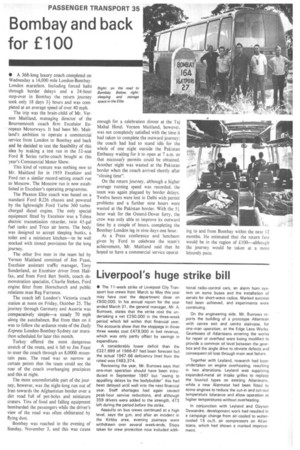Bombay and back for £100
Page 37

If you've noticed an error in this article please click here to report it so we can fix it.
• A 3611-long luxury coach completed on Wednesday a 14,000 mile London-BombayLondon marathon. Including forced halts through border delays and a 24-hour stop-over in Bombay the return journey took only 18 days 34 hours and was completed at an average speed of over 40 mph.
The trip was the brain-child of Mr. Vernon Maitland, managing director of the Bournemouth coach firm Excelsior European Motorways. It had been Mr. Maltland's ambition to operate a commercial service from London to Bombay and back and he decided to test the feasibility of this idea by making a test run in the 52-seat Ford R Series turbo-coach bought at this year's Commercial Motor Show.
This kind of venture was nothing new to Mr. Maitland for in 1959 Excelsior and Ford ran a similar record-setting coach run to Moscow. The Moscow run is now established in Excelsior's operating programme.
The Plaxton Elite coach was based on a standard Ford R.226 chassis and powered by the lightweight Ford Turbo 360 turbocharged diesel engine. The only special equipment fitted by Excelsior was a Telma electric transmission retarder, twin 45-gal fuel tanks and Trico air horns. The body was designed to accept sleeping bunks, a toilet and a miniature kitchen—to be well stocked with tinned provisions for the long journey.
The other five men in the team led by Vernon Maitland consisted of Jim Feast, Excelsior assistant traffic manager, Tony Sunderland, an Excelsior driver from Halifax, and from Ford Bert Smith, coach demonstration specialist, Charlie Stokes, Ford engine fitter from Hornchurch and public relations man Reg Farrance.
The coach left London's Victoria coach station at noon on Friday, October 25. The journey through Germany and Austria was comparatively simple—a steady 70 mph along the autobahnen. But from then on it was to follow the arduous route of the Daily Express London-Bombay-Sydney car marathon scheduled for later this month.
Turkey offered the most dangerous stretch of the route, and it fell to Jim Feast to steer the coach through an 8,00011 mountain pass. The road was so narrow at certain points that the team could see the rear of the coach overhanging precipices and this at night.
The most uncomfortable part of the journey, however, was the night-long run out of Iran towards the Afghanistan border over a dirt road full of pot-holes and miniature craters. Tins of food and falling equipment bombarded the passengers while the driver's view of the road was often obliterated by flying dust.
Bombay was reached in the evening of Sunday, November 3, and this was cause enough for a celebration dinner at the Taj Mahal Hotel. Vernon Maitland, however, was not completely satisfied with the time it had taken to complete the outward journey; the coach had had to stand idle for the whole of one night outside the Pakistan Embassy waiting for it to open at 7 a.m. so that necessary permits could be obtained. Another night was wasted at the Pakistan border when the coach arrived shortly after "closing time".
On the return journey, although a higher average running speed was recorded, the team was again plagued by border delays. Twelve hours were lost in Delhi with permit problems and a further nine hours were wasted at the Pakistan border. With the 54 hour wait for the Ostend-Dover ferry, the crew was only able to improve its outward time by a couple of hours, completing the Bombay-London leg in nine days one hour.
At a Press conference and' luncheon given by Ford to celebrate the team's achievement, Mr. Maitland said that he hoped to have a commercial service operat
ing to and from Bombay within the next 12 months. He estimated that the return fare would be in the region of £100—although the journey would be taken at a more leisurely pace.




















































































































